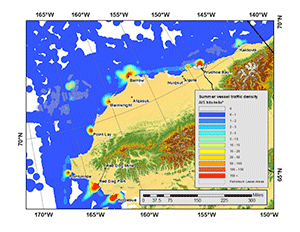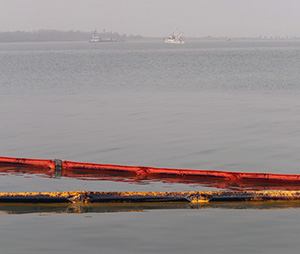Heavy fuel oil is considered the most significant threat to the Arctic. So why isn’t it banned yet?
Blog
On the precautionary principle and heavy fuel oil in the Arctic
On the 25th anniversary of the infamous grounding of the Exxon Valdez on Bligh Reef in Prince William Sound, Alaska, a barge carrying just under a million gallons of heavy fuel oil (HFO) collided with a ship in the Houston Ship Channel and spilled nearly 170,000 gallons (4,000 barrels) of oil into the Channel and Galveston Bay. If only the coincidence had prompted a vigorous public discussion among those contemplating increasing ship traffic in the Arctic of what might follow if such a collision were to occur there. So far it hasn’t.
The barge was on a short transit journey, transporting oil from Texas City to Bolivar, Texas—86 miles, or about the distance from Barrow, Alaska, to the neighboring coastal town of Wainwright. The collision occurred on Saturday, March 22. By Sunday oil was detectable 12 miles into the Gulf of Mexico. On Monday the first bird fatalities were reported. On Tuesday oil was washing up on Gulf Coast beaches, and the Texas Department of State Health Services issued a fish and shellfish consumption advisory [.pdf]: “Because of the presence of oil in Galveston Bay and the Gulf of Mexico, it is recommended that people not consume fish, shrimp or crabs from areas where oil is present.” Galveston Bay fisheries generated 5.8 million pounds of fish in 2012, valued at $16.4 million. The US Coast Guard issued a health and safety warning [.pdf] for exposure to oil: “Contact with the product can generate skin and respiratory system irritation. Vapors can irritate mucous membranes; can produce nausea, headache, difficulty breathing, loss of muscular coordination, blurred vision, asphyxia caused by lack of oxygen, and convulsions…If in contact with RMG 380 Marine Fuel or if you feel sick from any exposure seek medical advice immediately.” The latest reports from the Coast Guard put the wildlife casualties attributed to the spill at 300 birds, 39 dolphins, and 17 sea turtles. All of this despite fair weather conditions and the rapid deployment of 24 skimmer response vessels and about 69,000 feet of oil boom.
Coast Guard District 8 covers the Gulf of Mexico with six Marine Safety Units, including one in Texas City, virtually on top of where the collision happened. It has eleven cutters in Texas alone, five of which are stationed nearby in Galveston. Coast Guard District 17 in Alaska, by contrast, has more limited assets, the closest of which to the Arctic is a single cutter in Kodiak—more than 1000 miles away. Alaska’s fisheries are worth about $3 billion annually with average harvest of groundfish and shellfish at 4 billion and 92 million pounds, respectively; the potential economic damage from an oil spill is orders of magnitude greater.

Vessel densities along the North Slope of Alaska, US. Warmer colors indicate areas of higher vessel density. AIS Data courtesy of U.S. Coast Guard and NOAA Office of Coast Survey. (Click to enlarge. See here [.pdf] for more detail.)
Inadequate navigational support in the Arctic has become the subject of much discussion [.pdf], domestic [.pdf] and international. Studies highlight the lack of infrastructure [.pdf] as a major danger to and deterrent for increased use of Arctic shipping routes. With only 11% of the Arctic mapped to current nautical standards, and ice patterns shifting from increased melt, the likelihood of a serious collision or grounding increases as vessel traffic expands. The International Maritime Organization last week, at MEPC 66, formed a correspondence group on the proposed draft mandatory International Code for ships operating in polar waters (known as the Polar Code), which would finalize standard operating practices for vessels operating in the Arctic with respect to safety, voyage planning, and environmental protection. What isn’t on the agenda: a discussion of the carriage of heavy fuel oil, the same type of oil spilled in the Houston Ship Channel.
Contrary to the impression left by recent sensational reports of epic Arctic crossings, most voyages in the Arctic involve resupply missions and goods shipments to far north communities, as well as oil, gas, and minerals export. These vessels are much like the barge in Houston, making shorter transits to deliver smaller volumes (relative to, e.g., an oil tanker) of necessary goods like fuel.
Two incidents in the past two years are important reminders of the dangers to Arctic shipping. Around September 14, 2013 a Russian fuel tanker traveling the Northern Sea Route struck an ice floe and began taking on water. No fuel spill was reported. A year earlier the drill ship Kulluk returning from a season in the Arctic broke free of its towlines and grounded on a small island in the Gulf of Alaska. That accident happened relatively near to Coast Guard Station in Kodiak and other sources of help, yet it took 7 days to refloat the Kulluk.
With the next meeting of the Marine Environment Protection Committee on the horizon for October 2014, an opportunity to assess the pros and cons of restricting heavy fuel oil in the Arctic presents itself. But that can only happen if the issue becomes part of the agenda for the newly formed correspondence group and working group sessions. Even without a spill, a co-benefit of restricting HFO is cleaner emissions from ships transiting the Arctic, reducing the deposition of black carbon, which is a key contributor to Arctic warming. Thus far an outright ban has been viewed as premature, because of the pending .5% global fuel sulfur requirement and out of concern that it could deter vessels wanting to use the northern shipping routes.
After the Exxon Valdez spilled nearly 11 million gallons of oil into Prince William Sound, Congress passed the Oil Pollution Act of 1990, which required new tankers to be built with double hulls and existing single-hull tankers to be retrofitted with a double hull or taken out of operation. Had the Exxon Valdez been double hulled, the spill would have been reduced by 60%. A spill in the Arctic of similar proportion to the one in the Houston Ship Channel would be catastrophic, given the limited response capabilities, the distances involved, and the ensuing delays. The time to address that risk is before one happens, not after.

